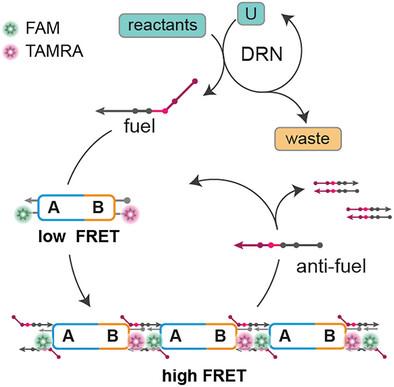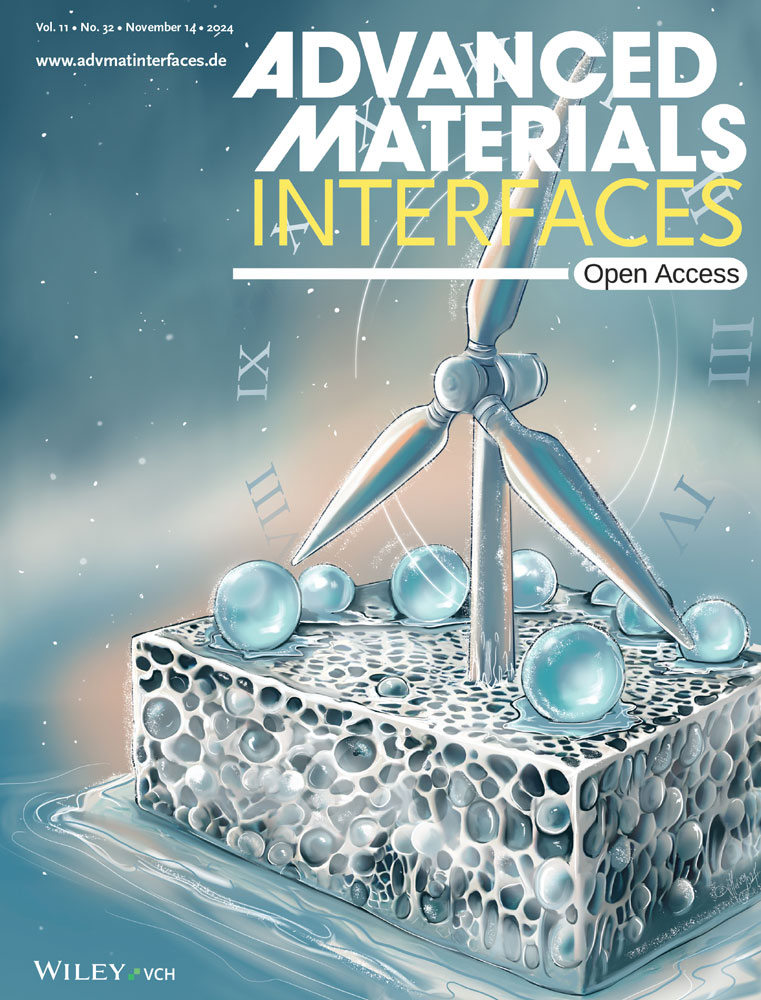Coupling DNA Origami Filament Growth to an Autocatalytic Production of Fuel
IF 4.3
3区 材料科学
Q2 CHEMISTRY, MULTIDISCIPLINARY
引用次数: 0
Abstract
In this study, the hierarchical assembly of DNA origami filaments (DOF) initiated by an autocatalytic DNA reaction network (DRN) is investigated. The so‐formed filaments are subsequently disassembled by toehold‐mediated strand displacement mechanisms. Using fluorescence resonance energy transfer, the kinetics of DOF growth after direct addition of fuel and compared it to the polymerization process triggered by the release of fuel from the DRN is monitored. Optimization of design and experimental conditions enabled to fine‐tune the kinetics of the two processes, ensuring that the release of fuel from the DRN outpaced the consumption of fuel by the downstream polymerization reaction. This resulted in a sustained and controlled DOF growth leading to micrometer‐long filament structures. Finally, although the presence of a toehold in the fuel strand reduced the efficiency of monomer association in the polymerization process, a 10‐fold excess of the anti‐fuel strand is efficient in dissociating the filament structures, permitting a potential reset for new reactions. The study shows that the kinetics of DNA origami filaments growth can be finely manipulated by a cascade of upstream reactions, suggesting alternative approaches for the creation of programmable DNA‐based nanomaterials that can sense and respond to more complex and distant events.

将 DNA 折纸丝的生长与燃料的自催化生产结合起来
本研究探讨了由自催化 DNA 反应网络(DRN)引发的 DNA 折纸细丝(DOF)的分层组装。由此形成的细丝随后在趾hold介导的链位移机制下被分解。利用荧光共振能量转移技术监测了直接添加燃料后 DOF 的生长动力学,并将其与 DRN 释放燃料引发的聚合过程进行了比较。通过优化设计和实验条件,对这两个过程的动力学进行了微调,确保 DRN 释放燃料的速度超过下游聚合反应消耗燃料的速度。这样,DOF 的增长就得到了持续和可控的控制,从而形成了微米长的丝状结构。最后,虽然燃料链中存在的趾痕降低了聚合过程中单体结合的效率,但过量 10 倍的反燃料链可以有效地解离丝状结构,从而为新反应提供了潜在的重置机会。这项研究表明,DNA 折纸细丝的生长动力学可以通过一连串的上游反应进行微调,这为创造可编程 DNA 纳米材料提供了另一种方法,这种材料可以感知和响应更复杂、更遥远的事件。
本文章由计算机程序翻译,如有差异,请以英文原文为准。
求助全文
约1分钟内获得全文
求助全文
来源期刊

Advanced Materials Interfaces
CHEMISTRY, MULTIDISCIPLINARY-MATERIALS SCIENCE, MULTIDISCIPLINARY
CiteScore
8.40
自引率
5.60%
发文量
1174
审稿时长
1.3 months
期刊介绍:
Advanced Materials Interfaces publishes top-level research on interface technologies and effects. Considering any interface formed between solids, liquids, and gases, the journal ensures an interdisciplinary blend of physics, chemistry, materials science, and life sciences. Advanced Materials Interfaces was launched in 2014 and received an Impact Factor of 4.834 in 2018.
The scope of Advanced Materials Interfaces is dedicated to interfaces and surfaces that play an essential role in virtually all materials and devices. Physics, chemistry, materials science and life sciences blend to encourage new, cross-pollinating ideas, which will drive forward our understanding of the processes at the interface.
Advanced Materials Interfaces covers all topics in interface-related research:
Oil / water separation,
Applications of nanostructured materials,
2D materials and heterostructures,
Surfaces and interfaces in organic electronic devices,
Catalysis and membranes,
Self-assembly and nanopatterned surfaces,
Composite and coating materials,
Biointerfaces for technical and medical applications.
Advanced Materials Interfaces provides a forum for topics on surface and interface science with a wide choice of formats: Reviews, Full Papers, and Communications, as well as Progress Reports and Research News.
 求助内容:
求助内容: 应助结果提醒方式:
应助结果提醒方式:


